Which Factors Affect the Visual Preference and User Experience: A Case Study of the Mulan River Greenway in Putian City, China
Abstract
1. Introduction
2. Literature Review and Theoretical Considerations
2.1. Environmental Perception
2.2. Recreational Facilities
2.3. Management and Maintenance
3. Materials and Methods
3.1. Study Area
3.2. Method
3.2.1. Constructing the Evaluation Criteria
3.2.2. Questionnaire Experiments
3.2.3. Environmental Attributes Determination
3.3. Data Analysis
3.3.1. Questionnaire Reliability and Validity Analysis
3.3.2. Discrete Choice Approach
3.3.3. Geographical Detector
3.3.4. Random Forest Model
4. Results
4.1. Evaluation System of Assessment of Users’ Experience
4.2. Comparison of Three Methods to Reveal the Factors Influencing User Experience
4.3. Various Environmental Attributes
4.4. Factors Affecting Visual Preference
5. Discussion
5.1. Evaluation of Users’ Experience
5.2. Influencing Factors of Users’ Experience
5.3. Variation in Environmental Attributes
5.4. Influencing Factors of Visual Preference
6. Conclusions
Supplementary Materials
Author Contributions
Funding
Data Availability Statement
Conflicts of Interest
References
- Keith, S.J.; Boley, B.B. Importance-performance analysis of local resident greenway users: Findings from Three Atlanta BeltLine Neighborhoods. Urban For. Urban Green. 2019, 44, 126426. [Google Scholar] [CrossRef]
- He, H.; Li, J.M.; Lin, X.W.; Yu, Y.W. Greenway Cyclists’ Visual Perception and Landscape Imagery Assessment. Front. Psychol. 2021, 12, 541469. [Google Scholar] [CrossRef] [PubMed]
- Chon, K.S. Understanding recreational traveler’s motivation, attitude and satisfaction. Tour. Rev. 1989, 44, 3–7. [Google Scholar] [CrossRef]
- Andrade, R.; Hondula, D.M.; Larson, K.L.; Lerman, S.B. Landscaping preferences influence neighborhood satisfaction and yard management decisions. Urban For. Urban Green. 2021, 59, 126983. [Google Scholar] [CrossRef]
- Kent, R.L.; Elliott, C.L. Scenic routes linking and protecting natural and cultural landscape features: A greenway skeleton. Landsc. Urban. Plan. 1995, 33, 341–355. [Google Scholar] [CrossRef]
- Gobster, P.H.; Westphal, L.M. The human dimensions of urban greenways: Planning for recreation and related experiences. Landsc. Urban. Plan. 2004, 68, 147–165. [Google Scholar] [CrossRef]
- Zheng, J.; Tarin, M.W.K.; Chen, G.; Zhang, Q.; Deng, C. The characteristics of plant clusters influence on the cooling effect: A case study in a subtropical Island Park, China. Glob. Ecol. Conserv. 2022, 34, e2055. [Google Scholar] [CrossRef]
- Dai, C.; Maruthaveeran, S.; Shahidan, M.F.; Chu, Y. Landscape Preference Evaluation of Old Residential Neighbourhoods: A Case Study in Shi Jiazhuang, Hebei Province, China. Forests 2023, 14, 375. [Google Scholar] [CrossRef]
- Huang, D.; Jiang, B.; Yuan, L. Analyzing the effects of nature exposure on perceived satisfaction with running routes: An activity path-based measure approach. Urban For. Urban Green. 2022, 68, 127480. [Google Scholar] [CrossRef]
- Yang, M.; Wu, R.; Bao, Z.; Yan, H.; Nan, X.; Luo, Y.; Dai, T. Effects of Urban Park Environmental Factors on Landscape Preference Based on Spatiotemporal Distribution Characteristics of Visitors. Forests 2023, 14, 1559. [Google Scholar] [CrossRef]
- Isik, A.I.; Vessel, E.A. From Visual Perception to Aesthetic Appeal: Brain Responses to Aesthetically Appealing Natural Landscape Movies. Front. Hum. Neurosci. 2021, 15, 676032. [Google Scholar] [CrossRef] [PubMed]
- Zheng, J.M.; Chen, X.Y.; Chen, L.G.; He, T.Y.; Rong, J.D.; Lin, Y.; Zheng, Y.S. Comprehensive evaluation of soil quality at different stand densities of Dendrocalamus minor var. amoenus plantations. Appl. Ecol. Environ. Res. 2020, 18, 5985–5996. [Google Scholar] [CrossRef]
- Srdjevic, B.; Lakicevic, M.; Srdjevic, Z. Fuzzy AHP Assessment of Urban Parks Quality and Importance in Novi Sad City, Serbia. Forests 2023, 14, 1227. [Google Scholar] [CrossRef]
- Foltête, J.; Ingensand, J.; Blanc, N. Coupling crowd-sourced imagery and visibility modelling to identify landscape preferences at the panorama level. Landsc. Urban Plan. 2020, 197, 103756. [Google Scholar] [CrossRef]
- Fan, Z.X.; Duan, J.; Lu, Y.; Zou, W.T.; Lan, W.L. A geographical detector study on factors influencing urban park use in Nanjing, China. Urban For. Urban Green. 2021, 59, 126996. [Google Scholar] [CrossRef]
- Zheng, J.; Huang, Y.; Chen, Y.; Guan, L.; Liu, Q. Subjective preference and visual attention to the attributes of ornamental plants in urban green space: An eye-tracking study. Forests 2022, 13, 1871. [Google Scholar] [CrossRef]
- Zheng, J.; Tarin, M.W.K.; Jiang, D.; Li, M.; Ye, J.; Chen, L.; He, T.; Zheng, Y. Which ornamental features of bamboo plants will attract the people most? Urban For. Urban Green. 2021, 61, 127101. [Google Scholar] [CrossRef]
- Ji, X.; Shang, F.; Liu, C.; Kang, Q.; Wang, R.; Dou, C. Prioritizing Environmental Attributes to Enhance Residents’ Satisfaction in Post-Industrial Neighborhoods: An Application of Machine Learning-Augmented Asymmetric Impact-Performance Analysis. Sustainability 2024, 16, 4224. [Google Scholar] [CrossRef]
- Gulcin, D.; Yalcinkaya, N.M. Correlating fluency theory-based visual aesthetic liking of landscape with landscape types and features. Geo-Spat. Inf. Sci. 2024, 27, 237–256. [Google Scholar] [CrossRef]
- Zhang, G.; Yang, J.; Wu, G.; Hu, X. Exploring the interactive influence on landscape preference from multiple visual attributes: Openness, richness, order, and depth. Urban For. Urban Green. 2021, 65, 127363. [Google Scholar] [CrossRef]
- Lee, J.; Lee, H.S.; Jeong, D.; Shafer, C.S.; Chon, J. The Relationship between User Perception and Preference of Greenway Trail Characteristics in Urban Areas. Sustainability 2019, 11, 4438. [Google Scholar] [CrossRef]
- Hofmann, M.; Gerstenberg, T.; Gillner, S. Predicting tree preferences from visible tree characteristics. Eur. J. For. Res. 2017, 136, 421–432. [Google Scholar] [CrossRef]
- Sonti, N.F.; Campbell, L.K.; Svendsen, E.S.; Johnson, M.L.; Novem Auyeung, D.S. Fear and fascination: Use and perceptions of New York City’s forests, wetlands, and landscaped park areas. Urban For. Urban Green. 2020, 49, 1–10. [Google Scholar] [CrossRef]
- Youssoufi, S.; Houot, H.; Vuidel, G.; Pujol, S.; Mauny, F.; Foltête, J. Combining visual and noise characteristics of a neighborhood environment to model residential satisfaction: An application using GIS-based metrics. Landsc. Urban Plan. 2020, 204, 103932. [Google Scholar] [CrossRef]
- Cai, K.Y.; Huang, W.W.; Lin, G.S. Bridging landscape preference and landscape design: A study on the preference and optimal combination of landscape elements based on conjoint analysis. Urban For. Urban Green. 2022, 73, 127615. [Google Scholar] [CrossRef]
- Evensen, K.H.; Hemsett, G.; Nordh, H. Developing a place-sensitive tool for park-safety management experiences from green-space managers and female park users in Oslo. Urban For. Urban Green. 2021, 60, 127057. [Google Scholar] [CrossRef]
- Yang, L.; Chang, H.; Li, J.; Xu, X.; Qiu, Z.; Jiang, X. A Comprehensive Evaluation of the Friendliness of Urban Facilities for the Elderly in Taipei City and New Taipei City. Sustainability 2023, 15, 13821. [Google Scholar] [CrossRef]
- Barnes, M. Planting and maintaining therapeutic gardens. In Therapeutic Landscapes: An Evidence-Based Approach to Designing Healing Gardens and Restorative Outdoor Spaces; Marcus, C.C., Sachs, N.A., Eds.; John Willey & Sons: Hoboken, NJ, USA, 2014; pp. 261–287. [Google Scholar]
- Mulan River Comprehensive Treatment Research Institute of Putian University. An Introduction to Comprehensive Management of Mulan River; People Daily Press: Beijing, China, 2023. [Google Scholar]
- Türker, H.B.; Kalkan, M.; Ortaç, G. Reimagining resilience: The transformative role of urban green areas in Türkiye’s disaster preparedness. Int. J. Disaster Risk Reduct. 2024, 106, 104397. [Google Scholar] [CrossRef]
- Zhu, C.; Ji, P.; Li, S. Effects of urban green belts on the air temperature, humidity and air quality. J. Environ. Eng. Landsc. 2017, 25, 39–55. [Google Scholar] [CrossRef]
- Jansson, M.; Fors, H.; Lindgren, T.; Wiström, B. Perceived personal safety in relation to urban woodland vegetation—A review. Urban For. Urban Green. 2013, 12, 127–133. [Google Scholar] [CrossRef]
- Wang, H.; Ye, J.; Tarin, M.W.K.; Liu, Y.; Zheng, Y. Tourists’ Safety Perception Clues in the Urban Forest Environment: Visual Quality, Facility Completeness, Accessibility—A Case Study of Urban Forests in Fuzhou, China. Int. J. Environ. Res. Public Health 2022, 19, 1293. [Google Scholar] [CrossRef] [PubMed]
- Joshi, A.; Kale, S.; Chandel, S.; Pal, D.K. Likert Scale: Explored and Explained. Br. J. Appl. Sci. Technol. 2015, 4, 396–403. [Google Scholar] [CrossRef]
- Yao, Y.; Liang, Z.; Yuan, Z.; Liu, P.; Bie, Y.; Zhang, J.; Wang, R.; Wang, J.; Guan, Q. A human-machine adversarial scoring framework for urban perception assessment using street-view images. Int. J. Geogr. Inf. Sci. 2019, 33, 2363–2384. [Google Scholar] [CrossRef]
- Lai, J.S.; Zou, Y.; Zhang, S.; Zhang, X.G.; Mao, L.F. glmm.hp: An R package for computing individual effect of predictors in generalized linear mixed models. J. Plant Ecol. 2022, 15, 1302–1307. [Google Scholar] [CrossRef]
- Hair, J.F.; Black, W.C.; Babin, B.J.; Anderson, R.E. Multivariate Data Analysis, 7th ed.; Pearson Prentice Hall: Old Bridge, NJ, USA, 2010. [Google Scholar]
- Wang, J.F.; Li, X.H.; Christakos, G.; Liao, Y.L.; Zhang, T.; Gu, X.; Zheng, X.Y. Geographical detectors-based health risk assessment and its application in the neural tube defects study of the Heshun region, China. Int. J. Geogr. Inf. Sci. 2010, 1, 107–127. [Google Scholar] [CrossRef]
- Wang, J.; Zhang, T.; Fu, B. A measure of spatial stratified heterogeneity. Ecol. Indic. 2016, 67, 250–256. [Google Scholar] [CrossRef]
- Liu, Q.; Luo, S.; Shen, Y.; Zhu, Z.; Yao, X.; Li, Q.; Tarin, M.W.K.; Zheng, J.; Zhuo, Z. Relationships between students’ demographic characteristics, perceived naturalness and patterns of use associated with campus green space, and self-rated restoration and health. Urban For. Urban Green. 2022, 68, 127474. [Google Scholar] [CrossRef]
- Li, X.; Wang, X.R.; Jiang, X.; Han, J.Y.; Wang, Z.Y.; Wu, D.Z.; Lin, Q.; Li, L.; Zhang, S.Y.; Dong, Y. Prediction of riverside greenway landscape aesthetic quality of urban canalized rivers using environmental modeling. J. Clean. Prod. 2022, 367, 133066. [Google Scholar] [CrossRef]
- Yang, W.; Fan, B.; Tan, J.; Lin, J.; Shao, T. The Spatial Perception and Spatial Feature of Rural Cultural Landscape in the Context of Rural Tourism. Sustainability 2022, 14, 4370. [Google Scholar] [CrossRef]
- Pouso, S.; Borja, A.; Fleming, L.E.; Gomez-Baggethun, E.; White, M.P.; Uyarra, M.C. Contact with blue-green spaces during the COVID-19 pandemic lockdown beneficial for mental health. Sci. Total Environ. 2021, 756, 143984. [Google Scholar] [CrossRef]
- Jiang, B.; Larsen, L.; Deal, B.; Sullivan, W.C. A dose–response curve describing the relationship between tree cover density and landscape preference. Landsc. Urban Plan. 2015, 139, 16–25. [Google Scholar] [CrossRef]
- Goller, J.; Mitrovic, A.; Leder, H. Effects of liking on visual attention in faces and paintings. Acta Psychol. 2019, 197, 115–123. [Google Scholar] [CrossRef] [PubMed]
- Li, H.; Browning, M.; Rigolon, A.; Larson, L.R.; Taff, D.; Labib, S.M.; Benfield, J.; Yuan, S.; McAnirlin, O.; Hatami, N.; et al. Beyond “bluespace” and “greenspace”: A narrative review of possible health benefits from exposure to other natural landscapes. Sci. Total Environ. 2023, 856, 159292. [Google Scholar] [CrossRef] [PubMed]

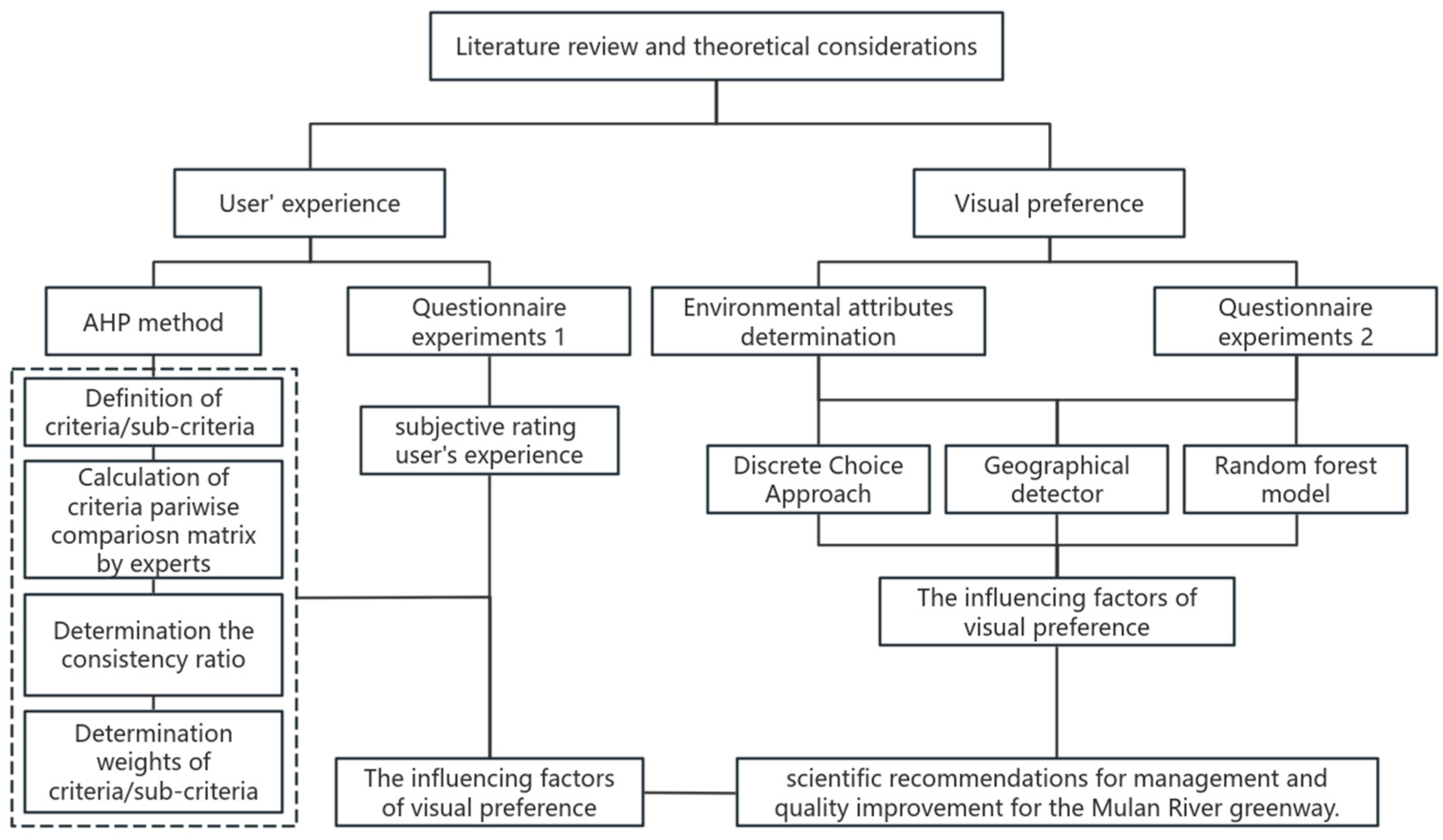
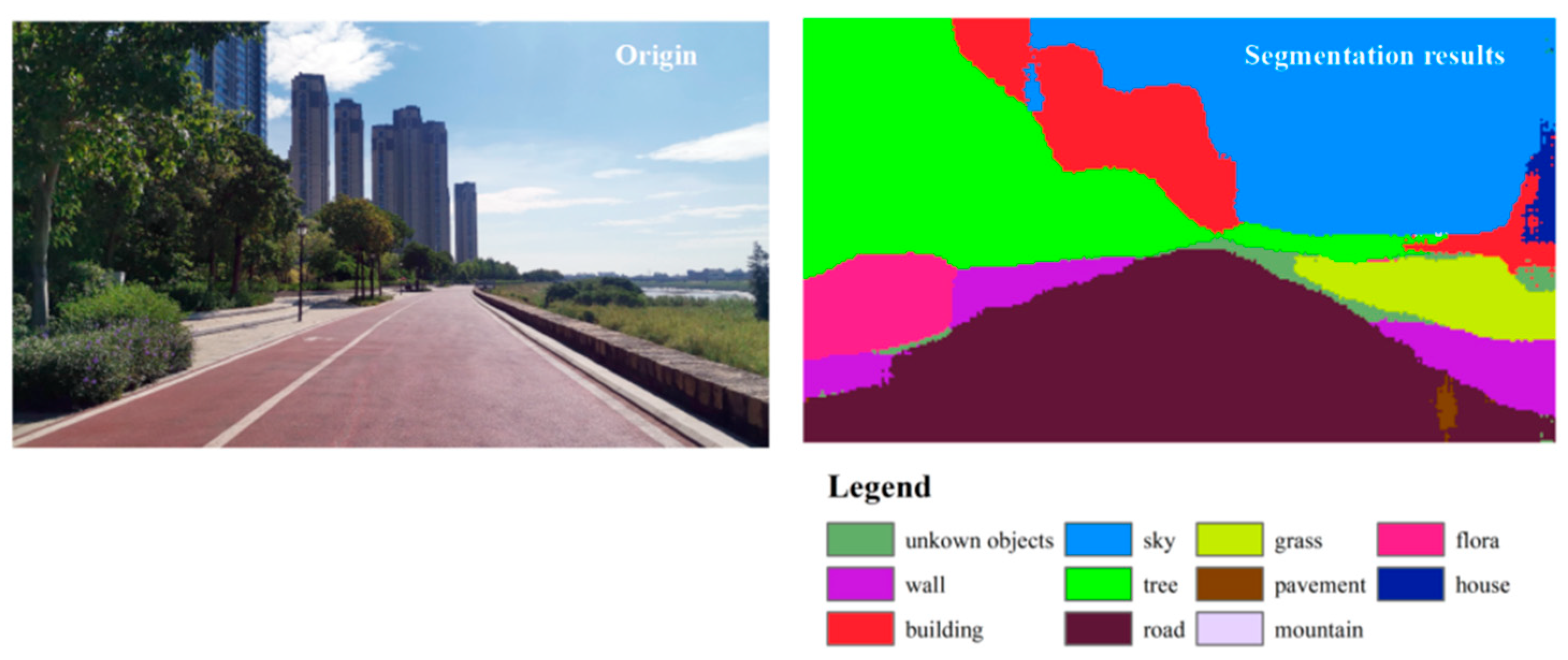
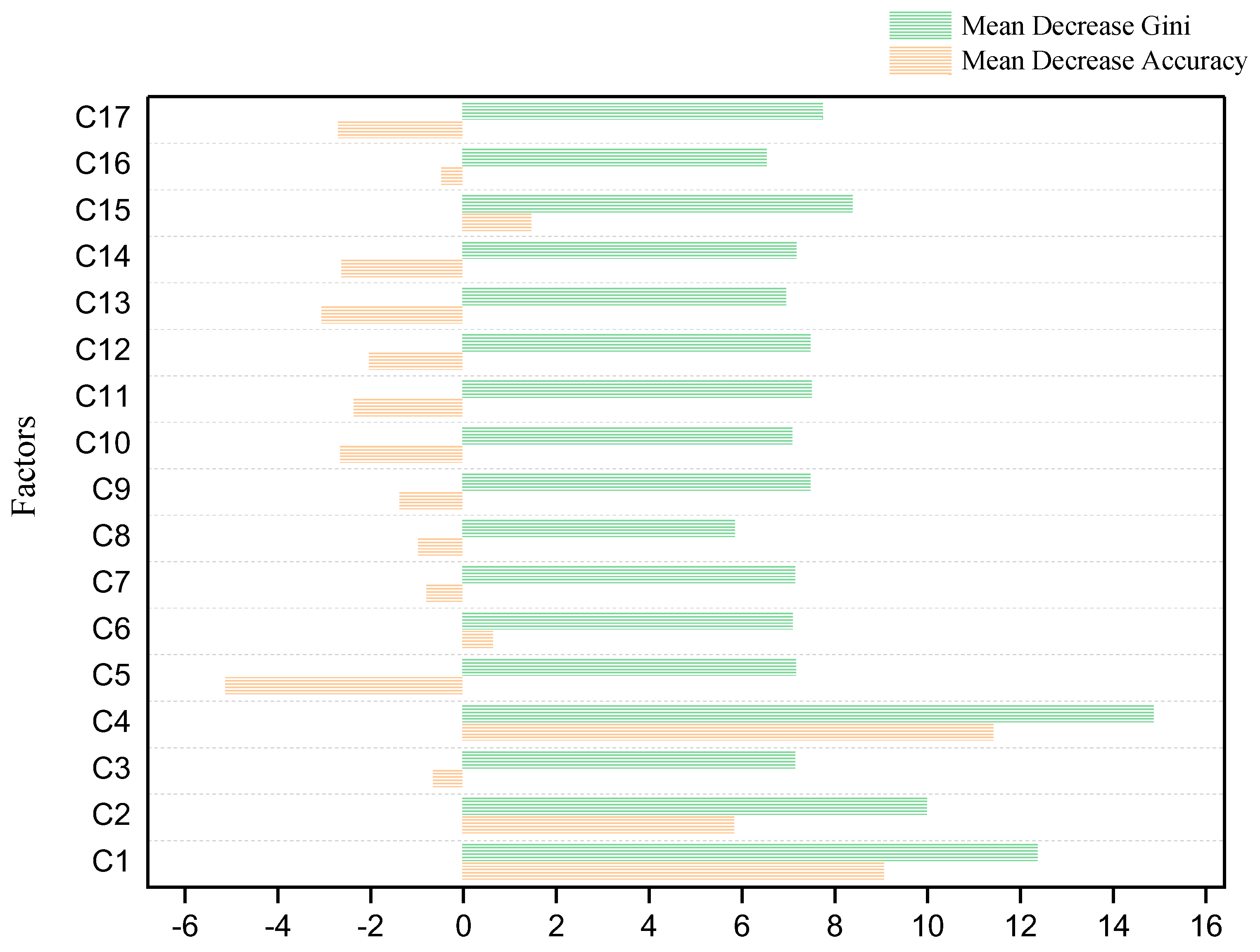
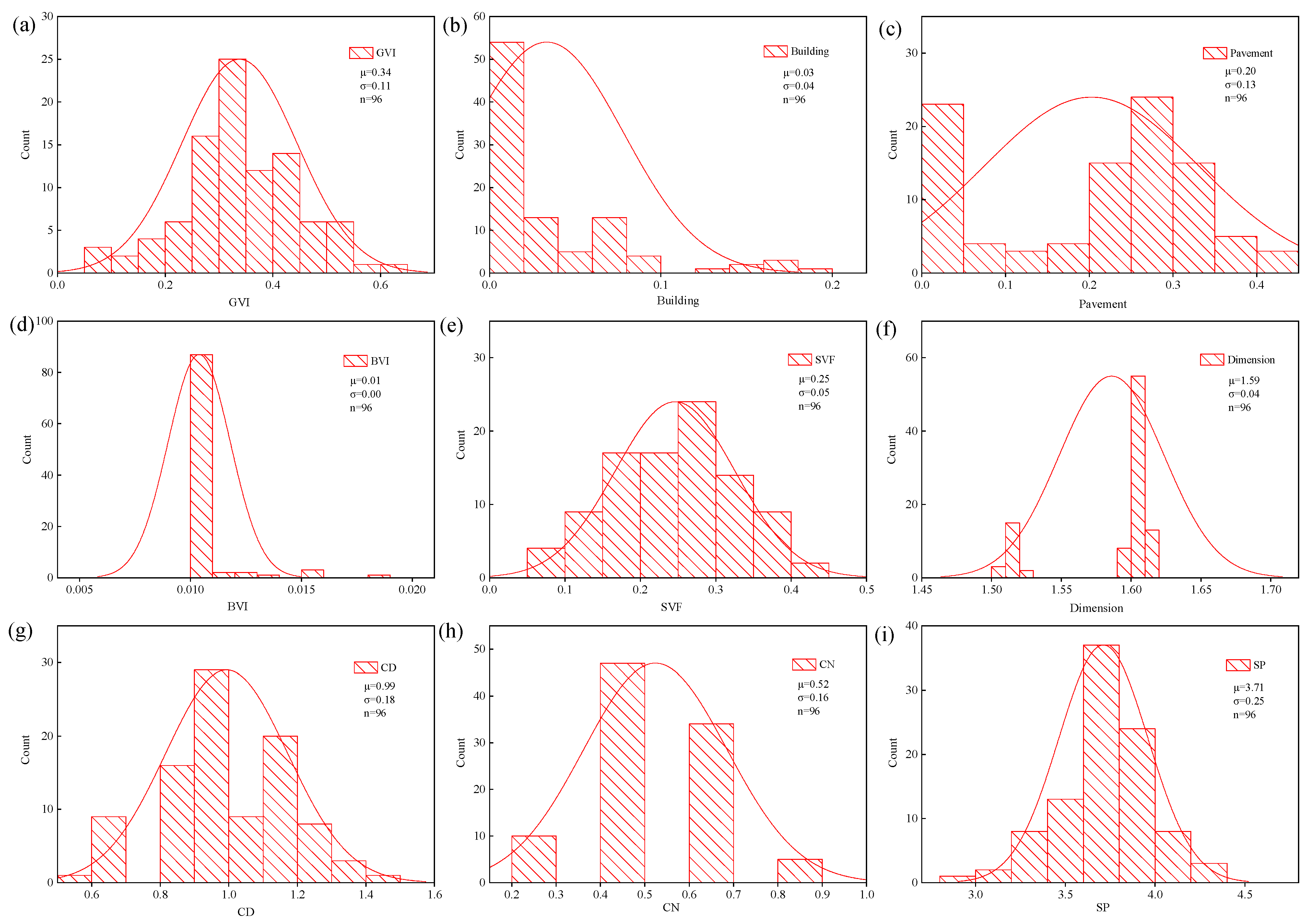
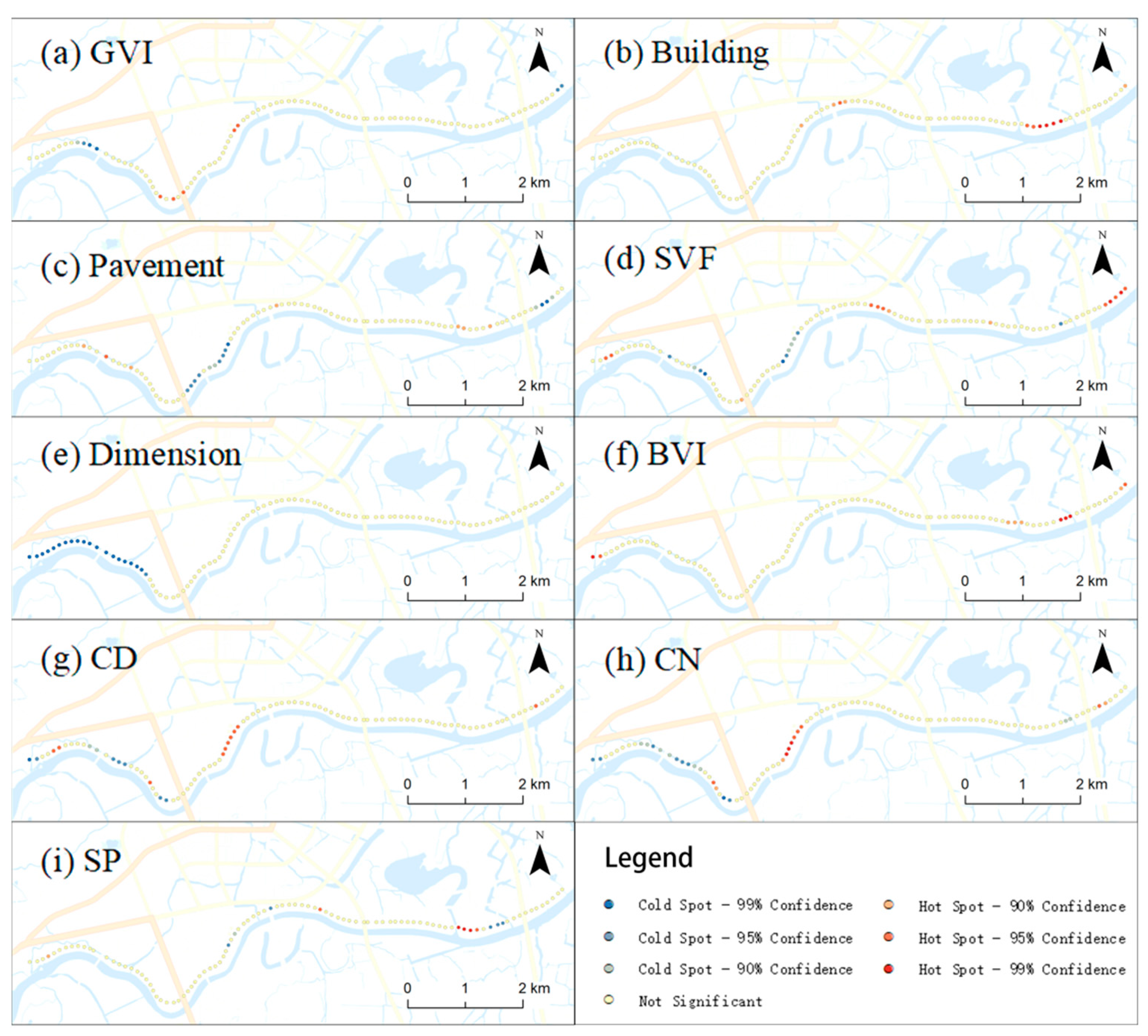
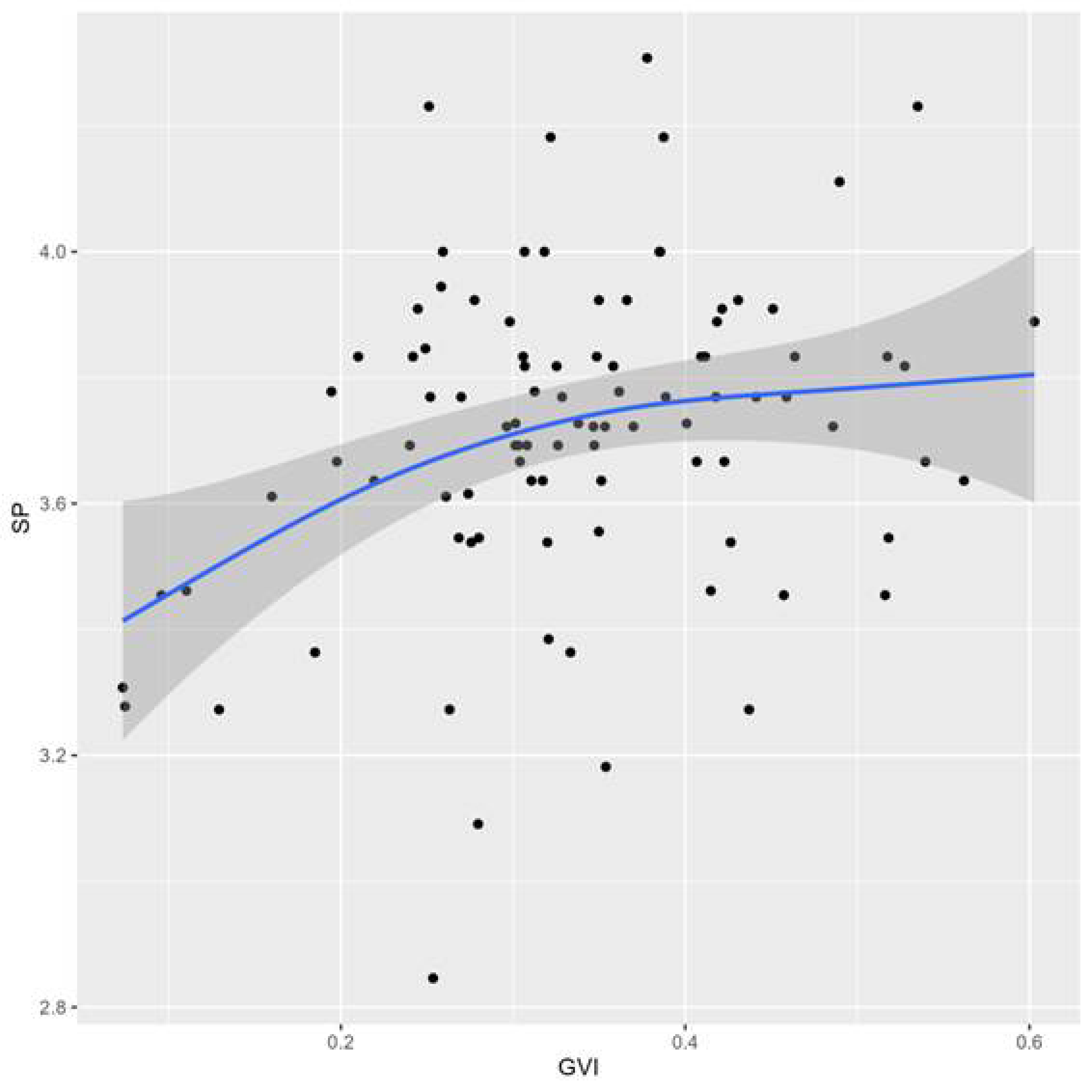
| Criteria | Sub-Criteria | Description | Literature |
|---|---|---|---|
| Environmental perception | Plant landscape aesthetics (C1) | The aesthetic value of the site’s plant environment | [8,25] |
| Air quality (C2) | Air quality conditions of the site | [31] | |
| Acoustical environment (C3) | The comfort level of the acoustic environment of the site | [7] | |
| Site leveling (C4) | Ground levelness of the site | [25] | |
| Physical comfort (C5) | Comfort feeling of the site | [7] | |
| Environmental characteristics (C6) | Character value of the site | [5] | |
| Sense of security (C7) | The feeling of safety given by the venue | [32] | |
| Recreational facilities | Exercise and fitness equipment (C8) | The number and use of sports construction equipment in the venue | [8] |
| Marking system (C9) | The completeness and clarity of the signage system of the venue | [8] | |
| Number of public toilets (C10) | The number of public toilets meets the demand for use | [8] | |
| Number of rubbish bins (C10) | The number of rubbish bins meets the usage demand | [8] | |
| Seating facilities (C12) | The number of seating facilities meets the demand for use | [8,25] | |
| Landscape furniture (C13) | The number and use of landscaping artifacts on the site | [8] | |
| Management and maintenance | Security protection (C14) | Safety facilities on the site | [33] |
| Site sanitation (C15) | Maintenance of hygiene within the site | [4] | |
| Public security management (C16) | Level of security management on the site | [33] | |
| Maintenance of facilities and plants (C17) | Maintenance of plants and facilities on the site | [4] |
| Criterion | Weight of Criterion (W) | Sub-Criterion | Weight of Sub-Criterion (WS) | Final Weight (W × WS) |
|---|---|---|---|---|
| Environmental perception | 0.625 | Plant landscape aesthetics (C1) | 0.084 | 0.053 |
| Air quality (C2) | 0.155 | 0.097 | ||
| Acoustical environment (C3) | 0.089 | 0.056 | ||
| Site leveling (C4) | 0.083 | 0.052 | ||
| Physical comfort (C5) | 0.315 | 0.197 | ||
| Environmental characteristics (C6) | 0.053 | 0.033 | ||
| Sense of security (C7) | 0.221 | 0.138 | ||
| Recreational facilities | 0.239 | Exercise and fitness equipment (C8) | 0.073 | 0.017 |
| Marking system (C9) | 0.241 | 0.058 | ||
| Number of public toilets (C10) | 0.304 | 0.073 | ||
| Number of rubbish bins (C11) | 0.116 | 0.028 | ||
| Seating facilities (C12) | 0.124 | 0.030 | ||
| Landscape furniture (C13) | 0.142 | 0.034 | ||
| Management and maintenance | 0.136 | Security protection (C14) | 0.238 | 0.033 |
| Site sanitation (C15) | 0.457 | 0.062 | ||
| Public security management (C16) | 0.186 | 0.025 | ||
| Maintenance of facilities and plants (C17) | 0.119 | 0.016 |
| Item | Mean ± SD | Percentage | ||||
|---|---|---|---|---|---|---|
| Ⅰ (%) | Ⅱ (%) | Ⅲ (%) | Ⅳ (%) | Ⅴ (%) | ||
| C1 | 3.58 ± 1.02 | 1.1 | 14.5 | 31.8 | 31.1 | 21.6 |
| C2 | 3.73 ± 0.98 | 0.7 | 9.5 | 32.2 | 31.1 | 26.5 |
| C3 | 3.44 ± 1.08 | 4.2 | 14.1 | 33.6 | 29.3 | 18.7 |
| C4 | 2.73 ± 1.13 | 14.8 | 26.5 | 38.5 | 10.6 | 9.5 |
| C5 | 3.39 ± 1.18 | 6.7 | 17.7 | 26.1 | 29.3 | 20.1 |
| C6 | 3.32 ± 1.12 | 6.7 | 13.4 | 39.2 | 22.3 | 18.4 |
| C7 | 3.36 ± 1.01 | 3.5 | 14.5 | 38.2 | 30 | 13.8 |
| C8 | 2.70 ± 0.94 | 14.8 | 15.2 | 59.7 | 6 | 4.2 |
| C9 | 3.15 ± 1.12 | 8.1 | 18 | 37.8 | 22.6 | 13.4 |
| C10 | 3.59 ± 1.13 | 3.2 | 15.2 | 28.6 | 25.8 | 27.2 |
| C11 | 3.16 ± 1.23 | 10.2 | 21.6 | 26.1 | 26.1 | 15.9 |
| C12 | 2.63 ± 1.16 | 20.1 | 25.1 | 33.2 | 14.8 | 6.7 |
| C13 | 2.98 ± 1.29 | 15.9 | 20.8 | 28.6 | 19.1 | 15.5 |
| C14 | 2.80 ± 1.32 | 20.1 | 24 | 26.9 | 14.1 | 14.8 |
| C15 | 3.40 ± 1.24 | 8.1 | 16.3 | 27.2 | 24.4 | 24 |
| C16 | 3.38 ± 1.01 | 2.1 | 16.3 | 39.9 | 25.1 | 16.6 |
| C17 | 3.00 ± 1.35 | 16.6 | 22.3 | 23.3 | 19.8 | 18 |
| Factors | B | S.E. | Wals | p | Exp (B) |
|---|---|---|---|---|---|
| Plant landscape aesthetics | 0.609 | 0.138 | 19.45 | 0.000 | 1.839 |
| Air quality | 0.536 | 0.148 | 13.014 | 0.000 | 1.708 |
| Site leveling | 0.632 | 0.132 | 23.046 | 0.000 | 1.881 |
| Constant | −5.608 | 0.876 | 40.958 | 0.000 | 0.004 |
| Factors | q-Statistic | p-Value | Factors | q-Statistic | p-Value |
|---|---|---|---|---|---|
| C1 | 0.100 | 0.000 | C10 | 0.015 | 0.453 |
| C2 | 0.065 | 0.000 | C11 | 0.006 | 0.810 |
| C3 | 0.004 | 0.912 | C12 | 0.009 | 0.715 |
| C4 | 0.104 | 0.000 | C13 | 0.013 | 0.469 |
| C5 | 0.026 | 0.158 | C14 | 0.016 | 0.373 |
| C6 | 0.014 | 0.484 | C15 | 0.032 | 0.063 |
| C7 | 0.021 | 0.295 | C16 | 0.004 | 0.931 |
| C8 | 0.004 | 0.943 | C17 | 0.019 | 0.264 |
| C9 | 0.016 | 0.434 |
| Dependent Variable | Estimate | SE | T-Value | p | I.perc (%) |
|---|---|---|---|---|---|
| Intercept | 4.973 | 1.188 | 4.185 | 0.000 | - |
| GVI | 0.875 | 0.279 | 3.138 | 0.002 ** | 68.26 |
| Building | 0.490 | 0.658 | 0.745 | 0.458 | 1.38 |
| Pavement | 0.035 | 0.223 | 0.156 | 0.876 | 0 |
| BVI | 10.119 | 20.502 | 0.494 | 0.623 | 1.54 |
| SVF | 0.635 | 0.363 | 1.748 | 0.084 | 11.07 |
| Dimension | −1.191 | 0.803 | −1.483 | 0.142 | 9.45 |
| CD | 0.058 | 0.550 | 0.105 | 0.917 | 4.92 |
| CN | −0.020 | 0.569 | −0.036 | 0.972 | 3.38 |
Disclaimer/Publisher’s Note: The statements, opinions and data contained in all publications are solely those of the individual author(s) and contributor(s) and not of MDPI and/or the editor(s). MDPI and/or the editor(s) disclaim responsibility for any injury to people or property resulting from any ideas, methods, instructions or products referred to in the content. |
© 2024 by the authors. Licensee MDPI, Basel, Switzerland. This article is an open access article distributed under the terms and conditions of the Creative Commons Attribution (CC BY) license (https://creativecommons.org/licenses/by/4.0/).
Share and Cite
Zheng, J.; Chen, Y.; Guan, L. Which Factors Affect the Visual Preference and User Experience: A Case Study of the Mulan River Greenway in Putian City, China. Forests 2024, 15, 1529. https://doi.org/10.3390/f15091529
Zheng J, Chen Y, Guan L. Which Factors Affect the Visual Preference and User Experience: A Case Study of the Mulan River Greenway in Putian City, China. Forests. 2024; 15(9):1529. https://doi.org/10.3390/f15091529
Chicago/Turabian StyleZheng, Junming, Yashan Chen, and Lei Guan. 2024. "Which Factors Affect the Visual Preference and User Experience: A Case Study of the Mulan River Greenway in Putian City, China" Forests 15, no. 9: 1529. https://doi.org/10.3390/f15091529
APA StyleZheng, J., Chen, Y., & Guan, L. (2024). Which Factors Affect the Visual Preference and User Experience: A Case Study of the Mulan River Greenway in Putian City, China. Forests, 15(9), 1529. https://doi.org/10.3390/f15091529








